Light
Ultraviolet, UVB
4.54 Billion Years Ago.
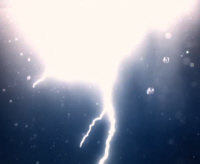
Lightning Flash
Earth began life as a molten hell. Its internal heat drove off any trace of moisture. But soon, the planet cooled and the first clouds grew. Then,
4.2 billion years ago, a deluge, the like of which the solar system had never seen before or since, rained down.
And again, thanks to those hydrogen bonds, water's boiling point is high enough to have allowed it to remain on the surface of the earth to the
present day.
So from quite early in its history, our home has been able to hang on to this most vital of ingredients. But to trace the origin of the next
ingredients, you have to look beyond our planet… to our nearest star. And the rays of light it sends our way.
This is the train from Los Mochis to Chihuahua, which inexplicably leaves at 6:00 a.m. in the morning. The local name for this area in all the
guidebooks is the Land of Turtles. Beautifully romantic name for this place on the Sea of Cortez.
But we just found out it's probably more likely
to have been called the land of Spinach-type Vegetables.
So we're going from the land of Spinach-type Vegetables to Chihuahua, which is the Land
of Very Small Dogs. One of the great Railway journeys of the world.
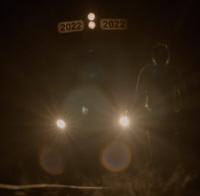
Chihuahua Train
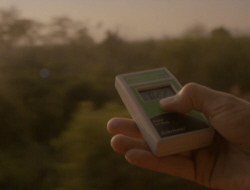
Radiometer
Almost all life depends on the energy that the Sun sends our way. But the sun is a far-from-benevolent companion because its radiant rain can be
as dangerous as it is nourishing.
We're still round about sea level now and the sun is quite low in the sky. It's about 7:00, so it's not been up long. I'm going to measure
the amount of UV radiation falling on every square centimetre with this, a digital, ultraviolet radiometer. At the moment, it says there is
about 22 µW per square centimetre falling on my skin. But as we claim in altitude, then that UVB light is going to have to travel through
less and less of the atmosphere, so less of it is going to be absorbed.
And sure enough, as the miles pass by and we head into the mountainous interior, the meter readings start to go up.
Now it's about 10:00, so the sun is significantly higher in the sky. The train's also climbed quite a bit in altitude. Now… w're getting
nearly 250 µW per square centimetre. So that's about a factor of ten higher.
And that's just because the UVB has had significantly less atmosphere to travel through, from the top of the Earth's atmosphere down to me. That's
more than enough to burn unprotected skin in just a few minutes. And that's because what arrived from the sun is far more than just the stuff
we can see.
Beyond the visible, the higher energy part of the spectrum, there is ultraviolet light, particularly UVB, which does get through the Earth's
atmosphere and gets to the surface. Now, UVB can be beneficial to life. We use it to produce vitamin D, for example. But because it's higher energy,
it can also be extremely damaging. It can damage DNA, it can burn our skin as well as give us a suntan, and, of course, ultimately, it can give us
skin cancer.
If ultraviolet light is a problem for life on Earth to deal with today, then the physicists might raise an interesting problem for the
biologists. Because we know that 3.5 billion years ago, when life on Earth began, although the sun was much dimmer in the visible part of the
spectrum, it was significantly brighter in the ultraviolet.
3.5 Billion Years Ago
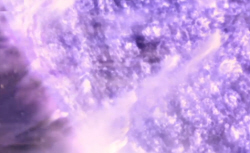
Ultraviolet
The young sun seems like a paradox. It was fainter to the eye, perhaps 30% less bright than the sun we enjoy today, yet rich in deadly
ultraviolet. Inside, the core was spinning much faster, which created more electromagnetic heating of the plasma on its surface. And this
plasma emitted more energy, not in the lower visible frequencies, but in the higher frequencies. Like X-rays… and ultraviolet.
It seems as if just as life was getting settled on its wet home, the faint young sun was making it tough to survive near the surface.
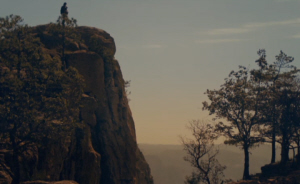
Copper Canyon
This is the top of Copper Canyon, so the summit of the railway journey. It's about 2,200 metres, which is about… somewhere between 7,000 and
8,000 feet. So I'll take a UV reading of the sun. It's actually reading about 260 now. Now, if you remember, at midday, down its sea level, we
were getting readings around 260. So although the sun has dropped in the sky, so the sunlight and the UV are coming through much more atmosphere,
that's been compensated for by the thinness of the air up here. I'm getting more UV now then I would have been at the same time of day at sea level.
It's hard to be sure but we think that it's these kind of radiation levels that early life had to deal with. Because back then, the sun's
ultraviolet output was significantly stronger.
So I think it is fair to say that that could have posed a significant threat to the development of early life on Earth.
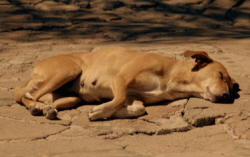
Let Sleeping Dogs Lie
Today, life has painted the surface of our home in all the colours of the rainbow. From greens to blues, reds to yellows, oranges and violets. And
the origin of all life's hues can be traced back to the way it interacts with sunlight
I'm a particle physicist, so I'm allowed to think of everything in terms of the interactions of particles. So I would picture of the light from
the sun as being really a rain of particles. Photons, they are called, particles of light of different energies, raining down on the surface of the
Earth. The blue ones are the highest-energy photons, the red ones are the lowest-energy photons and all the colours of the rainbow in the middle
are just simply photons of different energies.
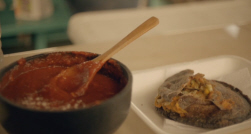
Chilli Salsa
For this, the chilli salsa which I see as red, there are pigment molecules in their that are absorbing the blue photons, the blue light from the
sun. The red ones, it doesn't interact with, so they bounce back into my eye, and that is why I see it as red. The same with the green chilli but in
this case the red photons are interacting, doing something, talking to pigments in here, and what I am seeing are the green photons and some of the
blue photons coming into my eye, mixing up, allowing me to see that as green.
Pigments bring colour to the world. The planet is painted by genes, honed by billions of years of evolution. Some colours warn of danger… Or
attract the pollinators.
Pigments are one of the ways that life has evolved to take on the sun's powerful ultraviolet light.






